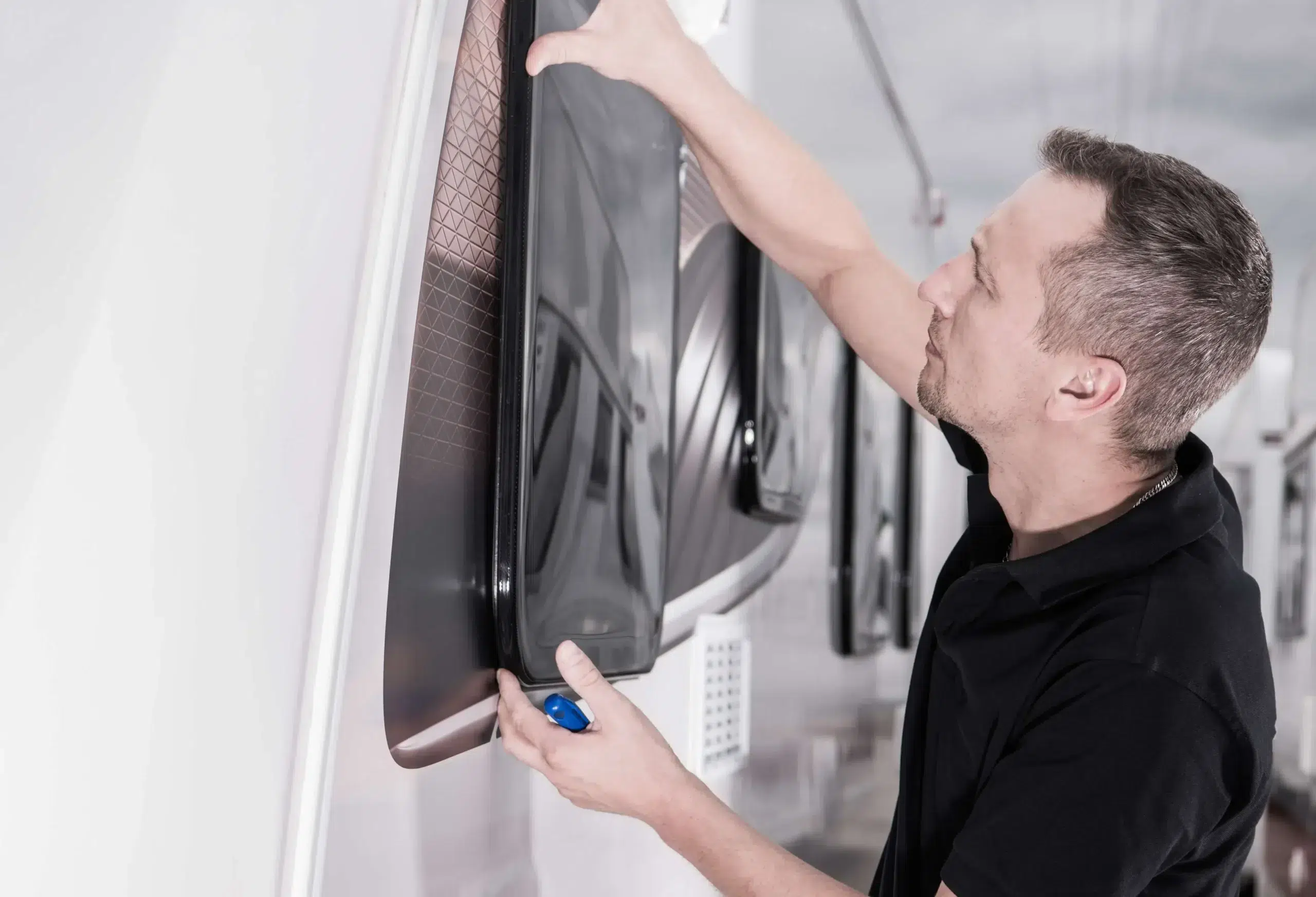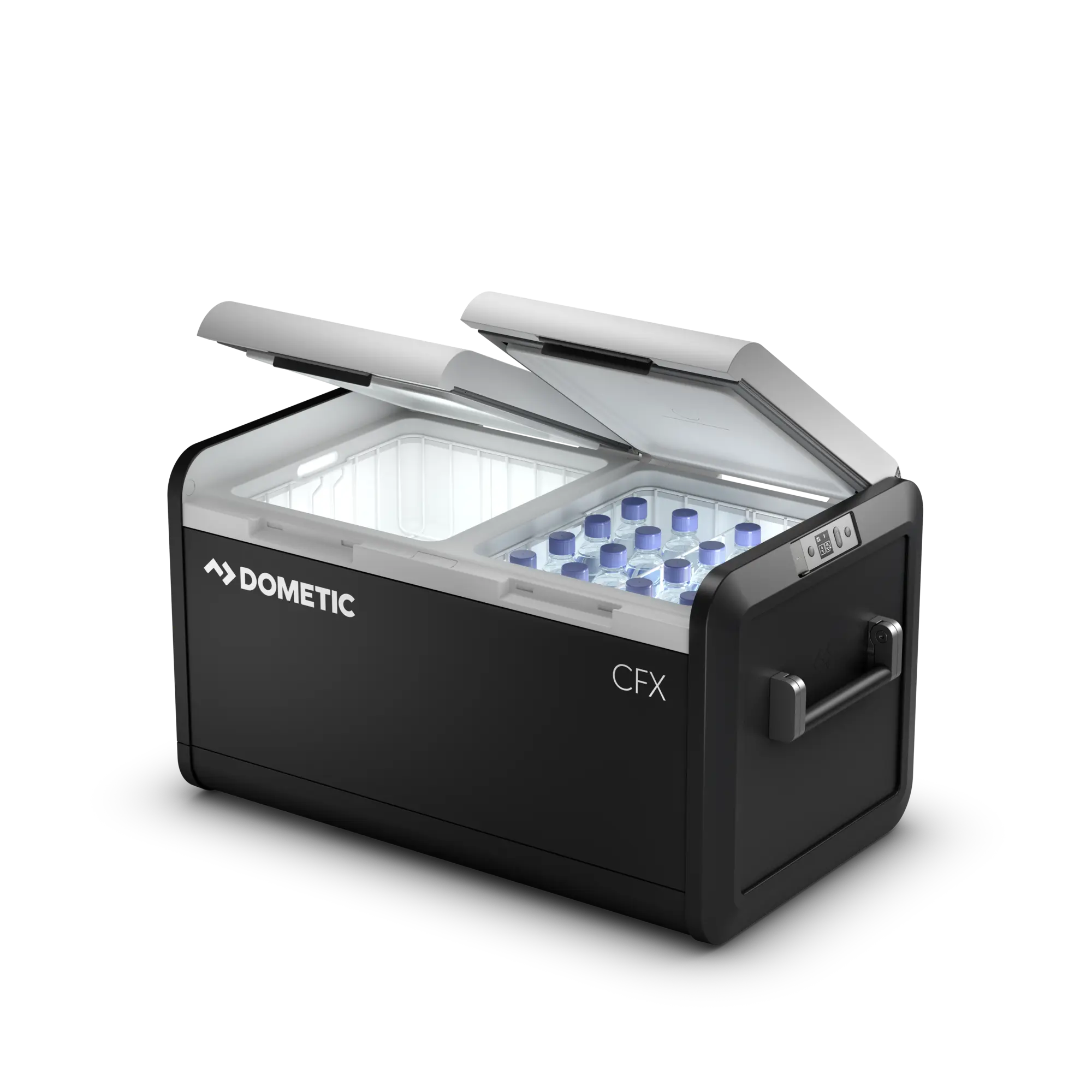Keeping Your Cool
SUMMER IS OUR FUN-LOVING relative. We can’t wait for summer’s arrival, but man, once summer is here, it is a full-tilt, nonstop, sizzle of activity. And no matter how much you love the fun, the heat, and the sweat of summer, chances are you will soon (and often) be seeking the crisp, cool interior of your RV. But is your RV prepared to keep summer outside, where it belongs For any newbies out there (learn some new terms on Page 12), there are some great tried-and-true tricks: parking in the shade, avoiding cooking during the day, cranking the AC to full capacity,
or just heading to a cooler climate. But sometimes your RV simply needs to put on more muscle. Because sweating ain’t cool, here are a few renovation tips to give your RV a better beach bod.
Block the Heat, Keep the View
You want to block the heat, but traditional shades and materials like Reflectix also kill your view. Fortunately, there are several good products out there to solve this problem, like EZ Snap, Blindsgalore®, Dual Roller RV Shades, and solar screens—but our favorite is Magne Shade. The Magne Shade System blocks 90 percent of harmful UV rays and heat, is custom cut to fit your windows snuggly, and mounts easily with small, powerful magnets. Best of all, installation requires no ladder or drilling and can be done in minutes for motorized and towable units. And taking it one more level of cool, your shades can be customized with the image of your choice, whether that’s an American flag or your favorite vista from Glacier National Park.
Protect That Soft Underbelly
You can’t see your undercarriage, but man, heat gets trapped down there like a mouse in a snake’s belly. Many folks only think to insulate their undercarriage in the cold months (to prevent pipes from bursting), but skirts also help keep cool air from escaping into the heat. There are multiple RV skirt options from DIY types to custom RV drape skirts, but AirSkirts stand out for their ease of setup and efficiency. These RV skirts use air as a natural insulator and are durable, made with heavy-duty PVC and military-grade valves. AirSkirts deploy in under 20 minutes, and best of all requires no modification to your RV.

Don’t Forget To
►Reseal doors, windows, and storage compartments (if needed) and replace any worn-out weather stripping.
►Apply reflective insulation to the top and back walls of cabinets and cupboards located on exterior walls.
►Cover the RV door window, especially if it’s not shaded by an awning.
►Increase roof vent covers to increase air circulation. Whether it’s increasing the number of vents, opening windows, or finding a road-friendly portable fan, keeping airflow up keeps temperatures down.
►Swap incandescent light bulbs for LEDs. Traditional incandescent bulbs actually generate a fair amount of heat—a big difference in a small space.
Improve Your Airflow System
Your air conditioner, the king of cool, does some pretty heavy lifting in the summer months. So if your AC is struggling, first make sure its maximum efforts aren’t being wasted on other inefficiencies. That can be forgetting to clean your AC filter, which you can wash in soapy water and let air dry. But there’s another key efficiency that you can optimize with a small installation:
airflow. Using a specially designed module that installs between the bottom of your AC unit and the cover plate, RV Airflow Systems capture 100 percent of the discharged air and direct it smoothly into your RV’s existing ductwork. Nonelectrical and nonmechanical, the module removes air friction and turbulence to allow your roof-mounted AC to work at full capacity, which can
improve efficiencies on average by 40 percent. Which is a very cool percentage.

Bring Out the Cool
With your RV buttoned up, be prepared to extend the kingdom of cool a bit further. Open that awning up, buy some comfy chairs, and make a space in that you want to spend time. You can cool the outdoor space even more by hanging some sunscreens to block the sun and adding a portable fan to create your own breeze. Then top it off with a touch of the deluxe: a Dometic CFX3 portable
refrigerator freezer. Powered by AC (110-240), DC (12/24 V), or DC solar power, these little fridges are user-friendly, weatherproof, durable, and easy to carry. Built with two compartments with
dual-zone technology, the Dometic CFX3 allows you to set either compartment for refrigeration or freezer. Just as cool, Dometic added a mobile app that allows you to control and monitor the temperature right from your phone. So those craft beers can achieve the perfect cool—just like you.
Unsure About RV Insurance?
Get the quick lowdown to answer every what-if.
LEAVING HOME without the insurance you need is like hitting the road without your hitch lock. You might get lucky and make it home unscathed—but hit the wrong bump and your investment is toast. However, RV insurance might be even more confusing than regular insurance, which is to say that it can be very confusing. So save your time and energy with some quick answers to your insurance questions.
Common Questions and What-Ifs
Is insurance required?
► Not every RV has to have insurance, and every state regulation is different. Double-check your state’s requirements before any trips.
What are my options?
► Like car insurance, you can get liability coverage or comprehensive coverage, which means more types of damage are covered in the event of an accident.
Do I need liability insurance?
► There are three times you typically must carry liability insurance: 1) if you’re driving a motorized RV, 2) if you still owe on a loan for the vehicle, or 3) if you’re driving a rental.
What if I still owe on a loan?
► You probably will have to carry full coverage because whoever owns the title will want to be compensated if you have a total loss.
What if I own a towable trailer with no loan?
► You might not have to carry insurance depending on what state you live in.
What if I’m renting using a credit card?
►Check with your card issuer to see whether your program offers additional insurance.
How much will it cost?
Just like a car, insurance costs vary widely based on the vehicle and the driver but can range anywhere from $125 annually for some liability-only policies and up to $1,000 annually for nicer
motorhomes.
Are discounts available?
Many insurance providers give discounts if you carry multiple policies. At a minimum, you should get a quote from your current automobile insurance company.
Is insurance the same for full-timers?
You might want to consider a special policy designed for folks who use their RV as a full-time residence. This typically includes some extra coverage.
Is the RV the only thing covered?
There are almost always extra things you can pay for, like pet injury coverage, the cost of hotels during an emergency, vacation liability, and more.
Are there RV-specific policies?
Most major insurance providers offer RV insurance. A great example is GEICO, which has several RV-specific policies to cover motorhomes and towable.
Important Insurance Premium Factors
►The provider you are using
►Type and size of your RV
►How often do you use your RV
►Custom equipment
► Who is driving your RV
►Discounts you may qualify for
How to Pick Your Provider
►It’s fine to pick the cheapest provider if you’re looking to pinch pennies. But, consider that if a major loss occurs, it will be a significant emotional event. And the quality of your provider will make a big difference in how you’ll make it through. That’s why we suggest starting with a provider you know and trust.


